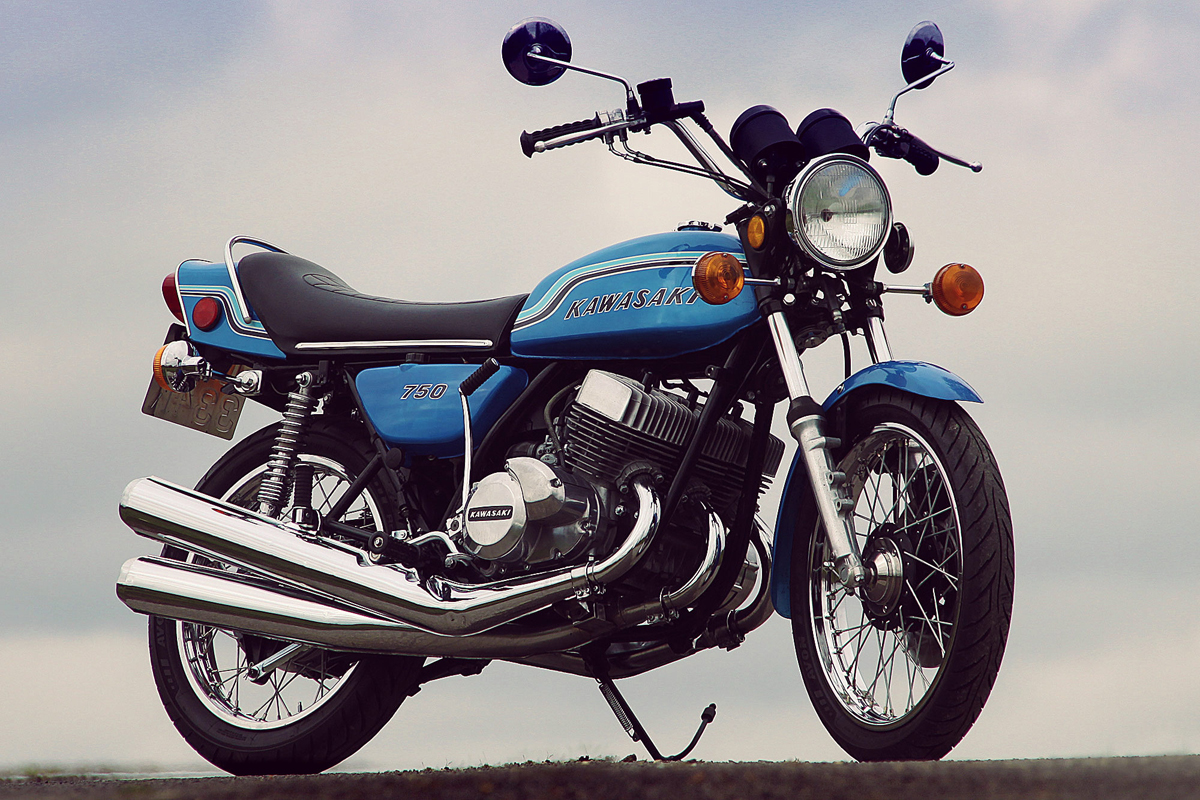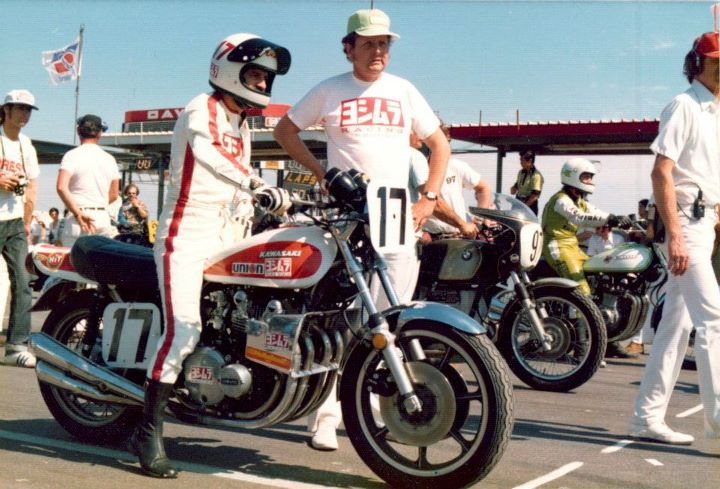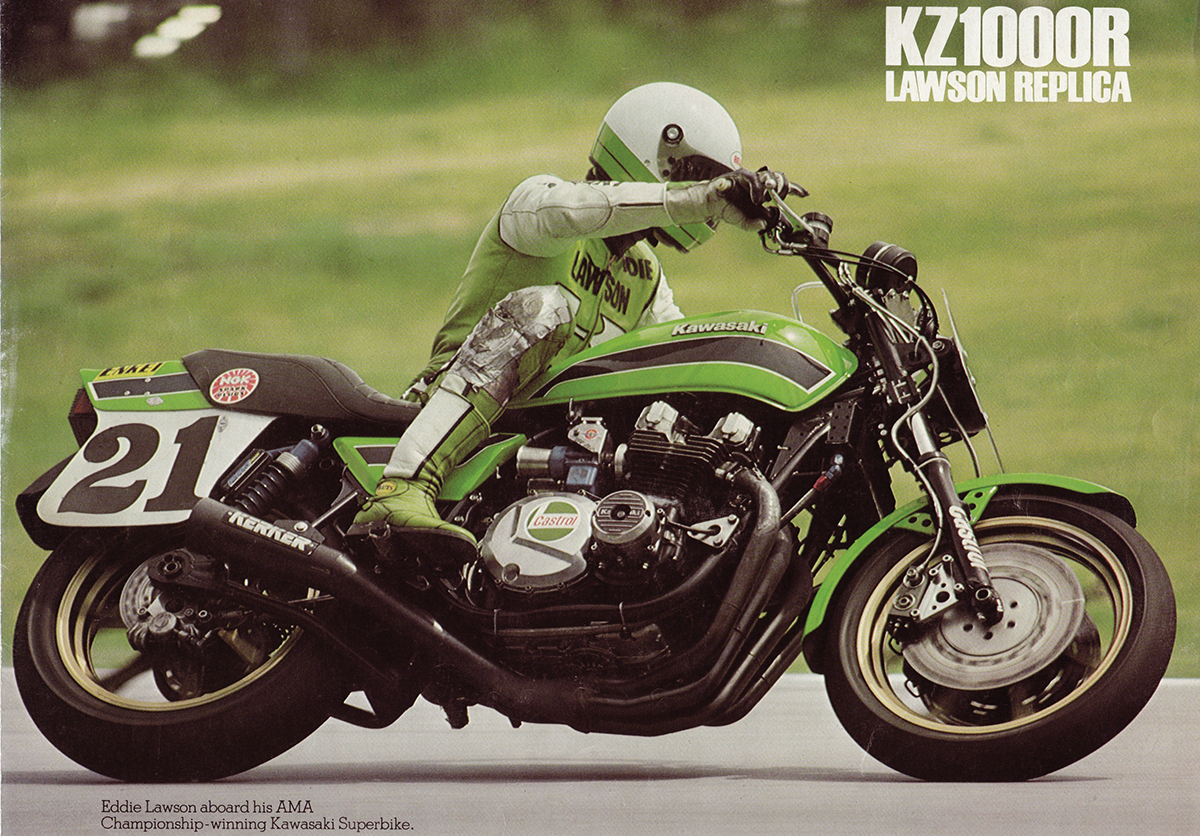
69 means different things to different people, but when it comes to motorcycling in the relatively modern era, it means only one thing – Honda CB750 Four K naught. The launch of the Honda was a gut punch to Kawasaki. They had been developing a 750cc four-cylinder four-stroke motorcycle during the late ’60s too. The launch of the Honda threw Kawasaki’s design team into a real tizz. Kawasaki has never been a company to follow. From the get-go, they developed a reputation for building exciting bikes with class-leading power. They scrapped the idea of a 750 and this gave birth to a project code-named “New York steak”. Kawasaki decided to build a four-cylinder four-stroke that would make power that was hitherto unknown from a production motorcycle.
I want to digress here for just a moment. Try to get your head around the world motorcycle landscape back in the ’60s and ’70s. It was so different to today, where new models, drowning in the latest technology, are spewed out by manufacturers like there is no tomorrow. Back then the world was still used to mainstream British bikes, which, by and large, were archaic in design. The Japanese were emerging as the dominant force in motorcycling globally, however, only Honda flew the four-stroke banner. Kawasaki ruled when it came to performance two strokes. The Kawi 750 H2 Mach 4 two-stroke triple, obliterated everything in sight in a straight line. The way it delivered its power as well as the dodgy handling resulted in many a sphincter clenching moment.

It was this raw and rough motorcycling landscape that made the purring, silky smooth and refined Honda Four, an instant worldwide success. Kawasaki was not going to be an “also-ran”. They wanted to maul the Honda, and anyone else for that matter, with a spectacular ‘tour de force’. People would literally stop and stare in awe if a CB750 rode past, revelling in the throaty four-cylinder burble. With project New York Steak, Kawasaki set about upstaging the Honda with a crushing blow that would have Big Red firmly relegated to “also-ran”. And so the first-ever Kawasaki ‘Z’ model, the legendary four-cylinder, Double Overhead Cam, four-stroke, 903cc, Z1, was conceived and birthed. In the early stage of its development, during project New York steak, it was known as the “V1 S”.
The design brief given to Norimasa ‘Ken’ Tada (senior stylist at Kawasaki), was the three S’s. The Z1 had to be Slim, Sleek and Sexy! It had to look nothing like the Honda. Tada was given a month to come up with a mock-up of the bike to present to Kawasaki Motor Corporation of America. He called home and informed his wife that she better forget that she had a husband for the next month! Working virtually round the clock, he flew to the States a month later with the mockup in a crate. The unveiling to Kawasaki America, who had the power to veto the design, if they thought that it did not have ‘American appeal’, was a nerve-wracking affair for Ben Tada. The design met with approval, albeit with the proviso that Tada “slim it down some more”.

Two test mules, disguised and badged as Honda’s, were ridden far and wide in the States, often at high speed, by Bryon Farnsworth and Paul Smart. Feedback was generally positive, however, the 83 HP Z1 made short work of its chain, resulting in the standard fitment of a chain oiler. Modern riders, who often don’t even lube their chains, let alone adjust them, just don’t understand the incredible advances in chain technology that has happened over the years. Back in the day, we adjusted our chains at least twice a week and even more often on a trip. We had no fancy chain lube either. It was gearbox oil that had to do the job. The Z1 was released to the public, to instant universal acclaim, in the latter part of 1972.
Kawasaki demonstrated its speed and reliability by wailing around Daytona to set a new World record, covering 2,631 miles at an average speed of 109,64 mph. French Canadian racer, Yvon Du Hamel, circulated a Yoshimura Z1 around Daytona at an incredible 160,28 mph. Interestingly, the 24 hr speed record was previously held by a modified R69S BMW. In stock trim, the Z1 punched out 83 hp and 73,5 Nm of torque at 8,500 rpm. It paralysed the 1972 version of the Honda CB750, which made less than 60 hp. The Z1 weighed a hefty 246 KG’S fully fuelled and ran a ¼ mile in 12,2 seconds, topping out at 125 mph. Tyres, chains and rear shocks tended to wear out quite swiftly, whereupon, like the other Jap bikes of the day, it wobbled like a demon at speed. Fact is, engine technology was outstripping chassis development. The decent handling bikes of the day, like Desmo Ducati’s, were suddenly not great when you upped their horsepower to Z1 levels.

The Z1 was an instant race track success. The popular 6-hour endurance race series for production bikes in Australia, sponsored by Pirelli, were dominated by Kawi Z1’s from 1973 to 1976. In the US, Superbike racing was hectic, being an almost ‘silhouette class’. The bikes looked vaguely stock, but were highly modified. Rob Muzzy, aided and abetted by the legendary ‘Pops’ Yoshimura, became the Kawasaki race guru, building some wickedly fast Z1’s. Eddie Lawson’s Z1 was good for 150 hp at 10250 rpm. The frame was stress relieved and heavily braced, to try and keep the power under control. Slick tyres on much wider rims, with serious suspension, made these some of the most spectacular production-based race bikes ever. Watching Lawson wrestle the fire breathing Z1 through the infield at Daytona and wail around the banking, was a spectacle never to be forgotten.

What I haven’t touched on is how stunning a looker the Z1 was. The modern Z900 RS, which pays homage to the original Z1, gives you some idea, but doesn’t quite have the same visual impact. The motor was blacked out with alloy side-covers with ‘DOHC’ cast in logos. In case you were in any doubt, the side-covers had badges with ‘900’, underlined by ‘Double Overhead Camshaft’. You were left with no doubt that this new Z1 was Big Muti! The paint job, Oh Lordy, the paint job! You could choose between Candy Brown and Orange or Candy Yellow and Green. Sounds gungy but the brown was almost more of a deep metallic burgundy. The bikes looked incredible. Ken Tada san, take a bow! Four beautiful pipes underlined the bike to perfection.

Yes, guys, those were heady days indeed! I was working for Club Motors, who were the importers of Kawasaki and BMW motorcycles at the time. Words fail me when I try and explain the incredible, palpable excitement, that the release of the Z1 elicited amongst the biking fraternity of the day. After three years, Honda’s CB750 Four had softened from the original ripsnorting K 0. We had got used to 750 fours. All of a sudden, here was a bike that violently upset our applecart. In truth, the two-stroke triple 750 Kawi, in its prime, was slightly faster than the Z1, but it could not match the way that the Z1 delivered its performance. Kawasaki, by 1973, had softened the performance of the H2, in an attempt to make it more palatable for general consumption and probably to not upstage its new Z1, in straight-line speed.

So next time you see a new ‘Z’ bike out on the road, spare a thought for the Grand Daddy of them all. The Mighty Z1, the first of the real Superbikes. It was the bike that entrenched Kawasaki as the company that you could rely on to give you really strong engines with big horsepower. Well done Kawasaki and long may that magnificent heritage continue!




